Published Paper by Sukhdev Singh
In this paper, we develop double acceptance sampling plan and group acceptance sampling plan for ... more In this paper, we develop double acceptance sampling plan and group acceptance sampling plan for an inverse Weibull distribution based on a truncated life test. We consider the median lifetime of the test units as a quality parameter and obtain the design parameters such as sample size and acceptance number. These plans are obtained under the consumer's risk and the producer's risk simultaneously involved at a certain confidence level. We present a simulation study to support the proposed methods and a comparison between single and double acceptance sampling plans is made. A real data set is also analyzed to illustrate the implementation of the proposed sampling plans. Further, the situation under which the proposed samplings plans can also be used for other percentiles points is discussed. Finally a conclusion is presented.
Industrial Engineering and Management Systems, 2015
Journal of Statistical Computation and Simulation, 2013
Statistical Papers, 2014
ABSTRACT In this paper, we establish reliability sampling plans for a two-parameter lognormal dis... more ABSTRACT In this paper, we establish reliability sampling plans for a two-parameter lognormal distribution when it is known that samples are progressive first-failure censored. An EM algorithm is developed to obtain maximum likelihood estimates of unknown parameters. Reliability sampling plans are obtained using two different criteria, namely minimizing the expected test time and minimizing the determinant of the variance covariance matrix of the maximum likelihood estimates, under a restriction on the total cost associated with the experiment and for given specifications on the operating characteristic curve. Finally, a numerical study is performed and specific comments are given.

IEEE Transactions on Reliability, 2016
For a lognormal distribution, in Bayesian framework, we consider estimation of unknown parameters... more For a lognormal distribution, in Bayesian framework, we consider estimation of unknown parameters and prediction of future observable when it is known that samples are hybrid censored. We derive Bayes estimates with respect to the squared error loss function under both informative and non-informative prior situations. These estimates are then computed using Lindley method, importance sampling, and OpenBUGS software. For comparison purposes, we also obtain maximum-likelihood estimates using expectation-maximization (EM) algorithm, and compute Fisher information matrix as well. Predictive estimates of future observable are obtained under the setup of one- and two-sample prediction problems. We further compute equal-tail and highest posterior density predictive intervals, the corresponding average interval length and coverage percentage. Proposed methods of estimation and prediction are compared numerically, and comments are made based on a simulation study. Two real data sets are also analyzed for illustration purposes.
Statistical Papers, 2016
In this paper, we consider the problem of estimating unknown parameters of an inverse Weibull dis... more In this paper, we consider the problem of estimating unknown parameters of an inverse Weibull distribution when it is known that samples are progressive type-I interval censored. We propose an EM algorithm to obtain maximum likelihood estimates and mid point estimates. For comparison purpose Bayes estimates are also obtained under the square error loss function. A simulation study is conducted to access the performance of the proposed estimators and recommendations are made on the basis of simulation results. A real data set is also analyzed in detail for an illustration purpose. Finally, by making use of expected Fisher information matrix various inspection times and optimal censoring schemes are obtained.

Journal of Statistical Computation and Simulation, 2017
ABSTRACT This paper deals with the problem of estimating unknown parameters of the Burr XII distr... more ABSTRACT This paper deals with the problem of estimating unknown parameters of the Burr XII distribution under classical and Bayesian approaches when samples are observed under progressive type-I interval censoring. Under classical approach we employ the stochastic expectation maximization algorithm to obtain maximum likelihood estimators for the unknown parameters and also compute associated interval estimates. Further under Bayesian approach we obtain Bayes estimators with respect to different symmetric, asymmetric and balanced loss functions. In this regard we use Tierney–Kadane and Metropolis–Hastings (MH) algorithm. For illustration purpose we analyse a real data set and conduct a Monte Carlo simulation study to observe the performance of the proposed estimators. Finally we present a discussion on inspection times and optimal censoring.
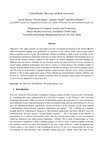
Indian Journal of Science and Technology, 2018
Objectives: This paper presents an up-to-date overview of research performed in the Virtual Reali... more Objectives: This paper presents an up-to-date overview of research performed in the Virtual Reality (VR) environment ranging from definitions, its presence in the various fields, and existing market players and their projects in the VR technology. Further an attempt is made to gain an insight on the psychological mechanism underlying experience in using VR device. Methods: Our literature survey is based on the research articles, analysis of the projects of various companies and their findings for different areas of interest. Findings: In our literature survey we observed that the recent advances in virtual reality enabling technologies have led to variety of virtual devices that facilitate people to interact with the digital world. In fact in the past two decades researchers have tried to integrate reality and VR in the form of intuitive computer interface. Improvements: This has led to variety of potential benefits of VR in many applications such as News, Healthcare, Entertainment, Tourism, Military and Defence etc. However despite the extensive research efforts in creating virtual system environments it is yet to become apparent in normal daily life.
Communications in Statistics - Simulation and Computation, 2019
AbstractThis paper considers the problems of estimation and prediction when lifetime data followi... more AbstractThis paper considers the problems of estimation and prediction when lifetime data following Poisson-exponential distribution are observed under type-I hybrid censoring. For both the problem...
Life Cycle Reliability and Safety Engineering, 2017
In this paper, we develop double acceptance sampling plan and group acceptance sampling plan for ... more In this paper, we develop double acceptance sampling plan and group acceptance sampling plan for an inverse Weibull distribution based on a truncated life test. We consider the median lifetime of the test units as a quality parameter and obtain the design parameters such as sample size and acceptance number. These plans are obtained under the consumer's risk and the producer's risk simultaneously involved at a certain confidence level. We present a simulation study to support the proposed methods and a comparison between single and double acceptance sampling plans is made. A real data set is also analyzed to illustrate the implementation of the proposed sampling plans. Further, the situation under which the proposed samplings plans can also be used for other percentiles points is discussed. Finally a conclusion is presented.
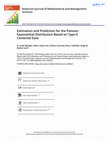
American Journal of Mathematical and Management Sciences, 2018
This article addresses the problems of estimation and prediction when the lifetime data following... more This article addresses the problems of estimation and prediction when the lifetime data following Poisson-Exponential distribution are observed under type-II censoring. We obtain maximum likelihood estimates and associated interval estimates under a classical approach, and Bayes estimates using various loss functions and associated highest posterior density interval estimates. Maximum likelihood estimates are obtained using the Newton-Raphson method and Expectation Maximization (EM) algorithm, and Bayes estimates are computed using importance sampling and Lindley approximation. We also compute shrinkage preliminary test estimates based on maximum likelihood and Bayes estimates. Further, we provide inference on the censored observations by making use of best unbiased and condition median predictors under a classical approach, and predictive estimates under the Bayesian paradigm using importance sampling. The associated predictive interval estimates are also obtained using different methods. Finally, we conduct a simulation study to compare the performance of all the proposed methods of estimation and prediction, and analyze a real data set for illustration purpose.
Multimedia Tools and Applications , 2022
Natural language processing (NLP) has recently gained much attention for representing and analyzi... more Natural language processing (NLP) has recently gained much attention for representing and analyzing human language computationally. It has spread its applications in various fields such as machine translation, email spam detection, information extraction, summarization, medical, and question answering etc. In this paper, we first distinguish four phases by discussing different levels of NLP and components of Natural Language Generation followed by presenting the history and evolution of NLP. We then discuss in detail the state of the art presenting the various applications of NLP, current trends, and challenges. Finally, we present a discussion on some available datasets, models, and evaluation metrics in NLP.
American Journal of Mathematical and Management Sciences, 2018
This article deals with problems of estimation and prediction under classical and Bayesian approa... more This article deals with problems of estimation and prediction under classical and Bayesian approaches when lifetime data following a lognormal distribution are observed under type-I progressive hybrid censoring. We first obtain maximum likelihood estimates, Bayes estimates, and corresponding interval estimates of unknown lognormal parameters. We then develop predictors to predict censored observations and construct prediction intervals. Further, we analyze two real data sets and conduct a simulation study to compare the performance of proposed methods of estimation and prediction. Finally, optimal censoring schemes are constructed under cost constraints and a conclusion is presented.
Journal of Applied Statistics, 2016
ABSTRACT In this paper we consider the problems of estimation and prediction when observed data f... more ABSTRACT In this paper we consider the problems of estimation and prediction when observed data from a lognormal distribution are based on lower record values and lower record values with inter-record times. We compute maximum likelihood estimates and asymptotic confidence intervals for model parameters. We also obtain Bayes estimates and the highest posterior density (HPD) intervals using noninformative and informative priors under square error and LINEX loss functions. Furthermore, for the problem of Bayesian prediction under one-sample and two-sample framework, we obtain predictive estimates and the associated predictive equal-tail and HPD intervals. Finally for illustration purpose a real data set is analyzed and simulation study is conducted to compare the methods of estimation and prediction.
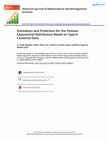
This article addresses the problems of estimation and prediction when the lifetime data following... more This article addresses the problems of estimation and prediction when the lifetime data following Poisson-Exponential distribution are observed under type-II censoring. We obtain maximum likelihood estimates and associated interval estimates under a classical approach, and Bayes estimates using various loss functions and associated highest posterior density interval estimates. Maximum likelihood estimates are obtained using the Newton-Raphson method and Expectation Maximization (EM) algorithm, and Bayes estimates are computed using importance sampling and Lindley approximation. We also compute shrinkage preliminary test estimates based on maximum likelihood and Bayes estimates. Further, we provide inference on the censored observations by making use of best unbiased and condition median predictors under a classical approach, and predictive estimates under the Bayesian paradigm using importance sampling. The associated predictive interval estimates are also obtained using different methods. Finally, we conduct a simulation study to compare the performance of all the proposed methods of estimation and prediction, and analyze a real data set for illustration purpose.
This article deals with problems of estimation and prediction under classical and Bayesian approa... more This article deals with problems of estimation and prediction under classical and Bayesian approaches when lifetime data following a lognormal distribution are observed under type-I progressive hybrid censoring. We first obtain maximum likelihood estimates, Bayes estimates, and corresponding interval estimates of unknown lognormal parameters. We then develop predictors to predict censored observations and construct prediction intervals. Further, we analyze two real data sets and conduct a simulation study to compare the performance of proposed methods of estimation and prediction. Finally, optimal censoring schemes are constructed under cost constraints and a conclusion is presented.
This paper deals with the problem of estimating unknown parameters of the Burr XII distribution u... more This paper deals with the problem of estimating unknown parameters of the Burr XII distribution under classical and Bayesian approaches when samples are observed under progressive type-I interval censoring. Under classical approach we employ the stochastic expectation maximization algorithm to obtain maximum likelihood estimators for the unknown parameters and also compute associated interval estimates.
In this paper, we consider the problem of estimating unknown parameters of an inverse Weibull dis... more In this paper, we consider the problem of estimating unknown parameters of an inverse Weibull distribution when it is known that samples are progressive type-I interval censored. We propose an EM algorithm to obtain maximum likelihood estimates and mid point estimates. For comparison purpose Bayes estimates are also obtained under the square error loss function using non-informative and informative prior situations. A simulation study is conducted to access the performance of the proposed estimators and recommendations are made on the basis of simulation results. A real data set is also analyzed in detail for an illustration purpose. Finally, by making use of expected Fisher information matrix various inspection times and optimal censoring schemes are obtained.
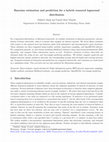
For a lognormal distribution, in Bayesian framework, we consider estimation of unknown parameters... more For a lognormal distribution, in Bayesian framework, we consider estimation of unknown parameters, and prediction of future observable, when it is known that samples are hybrid censored. We derive Bayes estimates with respect to the squared error loss function under both informative and non-informative prior situations. These estimates are then computed using Lindley method, importance sampling, and OpenBUGS software. For comparison purpose, we also obtain maximum likelihood estimates using expectation-maximization (EM) algorithm, and compute Fisher information matrix as well. Predictive estimates of future observable are obtained under the setup of one-and two-sample prediction problems. We further compute equal-tail and highest posterior density predictive intervals, the corresponding average interval length and coverage percentage. Proposed methods of estimation and prediction are compared numerically, and comments are made based on a simulation study. Two real data sets are also analyzed for illustration purpose.
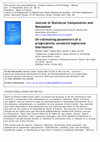
Taylor & Francis
We consider the problem of making statistical inference on unknown parameters of a lognormal dist... more We consider the problem of making statistical inference on unknown parameters of a lognormal distribution under the assumption that samples are progressively censored. The maximum likelihood estimates (MLEs) are obtained by using the expectation-maximization algorithm. The observed and expected Fisher information matrices are provided as well. Approximate MLEs of unknown parameters are also obtained. Bayes and generalized estimates are derived under squared error loss function. We compute these estimates using Lindley's method as well as importance sampling method. Highest posterior density interval and asymptotic interval estimates are constructed for unknown parameters. A simulation study is conducted to compare proposed estimates. Further, a data set is analysed for illustrative purposes. Finally, optimal progressive censoring plans are discussed under different optimality criteria and results are presented.










Uploads
Published Paper by Sukhdev Singh